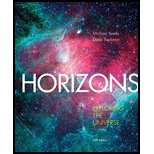
Phobos obits Mars at a distance of 9376 km from the center of the planet and has a period of 0.3 189 days. Assume Phobos’s orbit is circular. Calculate the mass of Mars. (Hints: Use the circular orbit velocity formula in Reasoning with Numbers 4-1; make sure to convert relevant quantities to units of meters, kilograms. and seconds.)
To calculate:
The mass of Mars based on the distance and orbit angle of Phobos
Answer to Problem 5P
The mass of Mars =
Explanation of Solution
Given Information:
Radius of orbit = 9376 Km
Period of Orbit = 0.3189 Days
Formula Used:
Circular orbit velocity =
Also, VS=distance/time
Calculation:
Assume Phobos (Moons) orbit to be circular.
First convert the quantities into proper units
Now,
Circular Velocity =
Where, G = Gravitational Constant =
r = Radius of Planet. (m)
m= Mass of Planet (Kg)
Rewriting in terms of m
∴ m =
For finding circular velocity that is distance covered per unit time.
∴ VS =Distance/time
Distance between but circumference of orbit.
∴
∴ Moon must cover 5.9 x 107 m distance in 27552.96 sec
∴ its circular velocity must be,
∴ put all the Values in mass of Mars formula,
=
=
Conclusion:
Mass of Mars is
Want to see more full solutions like this?
Chapter 17 Solutions
Horizons: Exploring the Universe (MindTap Course List)
Additional Science Textbook Solutions
Campbell Biology: Concepts & Connections (9th Edition)
Biology: Concepts and Investigations
Campbell Essential Biology with Physiology (5th Edition)
Fundamentals Of Thermodynamics
Campbell Biology (11th Edition)
- Details solution No chatgpt plsarrow_forwardPlease solve and answer the problem correctly please.Thank you!!arrow_forwardWill you please walk me through the calculations in more detail for solving this problem? I am a bit rusty on calculus and confused about the specific steps of the derivation: https://www.bartleby.com/solution-answer/chapter-3-problem-15e-modern-physics-2nd-edition/9780805303087/7cf8c31d-9476-46d5-a5a9-b897b16fe6fcarrow_forward
- please help with the abstract. Abstract - This document outlines the format of the lab report and describes the Excel assignment. The abstract should be a short paragraph that very briefly includes the experiment objective, method, result and conclusion. After skimming the abstract, the reader should be able to decide whether they want to keep reading your work. Both the format of the report and the error analysis are to be followed. Note that abstract is not just the introduction and conclusion combined, but rather the whole experiment in short including the results. I have attacted the theory.arrow_forwardUsing the Experimental Acceleration due to Gravity values from each data table, Data Tables 1, 2, and 3; determine the Standard Deviation, σ, mean, μ, variance, σ2 and the 95% Margin of Error (Confidence Level) Data: Ex. Acc. 1: 12.29 m/s^2. Ex. Acc. 2: 10.86 m/s^2, Ex. Acc. 3: 9.05 m/s^2arrow_forwardIn the Super Smash Bros. games the character Yoshi’s has a “ground pound” down special move where he launches himself downward to attack an enemy beneath him. A) If Yoshi flings himself downwards at 9.76 miles per hour to hit an enemy 10.5 m below him, how fast is Yoshi traveling when he hits the enemy? 1 mile = 1609 m B) How much time does it take Yoshi to hit the enemy beneath him?arrow_forward
- No chatgpt pls will upvotearrow_forward1.62 On a training flight, a Figure P1.62 student pilot flies from Lincoln, Nebraska, to Clarinda, Iowa, next to St. Joseph, Missouri, and then to Manhattan, Kansas (Fig. P1.62). The directions are shown relative to north: 0° is north, 90° is east, 180° is south, and 270° is west. Use the method of components to find (a) the distance she has to fly from Manhattan to get back to Lincoln, and (b) the direction (relative to north) she must fly to get there. Illustrate your solutions with a vector diagram. IOWA 147 km Lincoln 85° Clarinda 106 km 167° St. Joseph NEBRASKA Manhattan 166 km 235° S KANSAS MISSOURIarrow_forwardPlz no chatgpt pls will upvotearrow_forward

 Stars and GalaxiesPhysicsISBN:9781305120785Author:Michael A. Seeds, Dana BackmanPublisher:Cengage Learning
Stars and GalaxiesPhysicsISBN:9781305120785Author:Michael A. Seeds, Dana BackmanPublisher:Cengage Learning Foundations of Astronomy (MindTap Course List)PhysicsISBN:9781337399920Author:Michael A. Seeds, Dana BackmanPublisher:Cengage Learning
Foundations of Astronomy (MindTap Course List)PhysicsISBN:9781337399920Author:Michael A. Seeds, Dana BackmanPublisher:Cengage Learning
 Horizons: Exploring the Universe (MindTap Course ...PhysicsISBN:9781305960961Author:Michael A. Seeds, Dana BackmanPublisher:Cengage Learning
Horizons: Exploring the Universe (MindTap Course ...PhysicsISBN:9781305960961Author:Michael A. Seeds, Dana BackmanPublisher:Cengage Learning AstronomyPhysicsISBN:9781938168284Author:Andrew Fraknoi; David Morrison; Sidney C. WolffPublisher:OpenStax
AstronomyPhysicsISBN:9781938168284Author:Andrew Fraknoi; David Morrison; Sidney C. WolffPublisher:OpenStax





